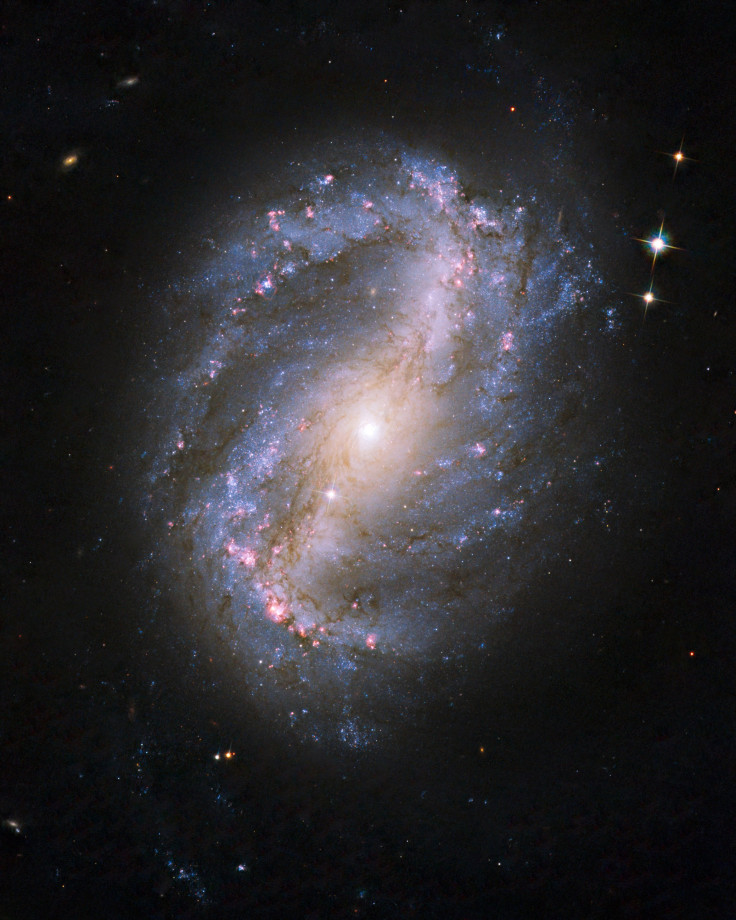NASA's Hubble Captures Amazing Image Of Spiral Galaxy Dying, Losing Gas [PHOTOS]

NASA's Hubble Space Telescope has captured the spectacular sight of a spiral galaxy in the process of losing its gas and becoming a dead relic.
The image from the Hubble telescope showed the galaxy, which has been given the designation D100, plunging toward the center of the giant Coma galaxy cluster and being stripped of its gas in the process. The dark brown streaks that could be observed extending from the D100's central region are actually dust escaping from it. The dust is part of a long, thin tail, which is also made of hydrogen gas that extends from the galaxy's core like taffy.
Once the galaxy loses of all its gas, D100 will then be a dead relic and will no longer have the ability to birth new stars. It will only continue shining with the help of old, red stars.
Hubble spotted a wayward spiral galaxy losing its gas as it plunges toward the center of the massive cluster and is roughed up as it plows through the intergalactic medium: https://t.co/gRFlIlhzRj pic.twitter.com/ZAcpchpYZF
— Hubble (@NASAHubble) January 24, 2019
William Cramer of Yale University in New Haven, Connecticut, leader of the team using the Hubble observations, explained in a report on Yale's website that this phenomenon is actually common in massive clusters, where a galaxy could go from "healthy spiral full of star formation" to a "red and dead galaxy," though D100's case is "particularly extreme."
Cramer added that while scientists have been aware of this process called "ram pressure stripping" for decades now, the Hubble's image gave the best and most detailed look at a galaxy losing its material.
Ram pressure stripping occurs when a galaxy is pulled by gravity toward the dense center of a massive cluster of thousands of galaxies. While it is falling into the center, the galaxy wades through intergalactic material, which expels gas and dust from the galaxy. Eventually, all of the galaxy's hydrogen gas, which is necessary to create new stars, will run out and thus the galaxy will die. D100 has been going through this process for about 300 million years now.
In findings published in The Astrophysical Journal, scientists noted that D100 is unique from other galaxies who have gone through this gas-loss process. The galaxy's most unusual feature is its long, thin tail made of dust and gas which stretches to about 200,000 light-years away. This is the width of two Milky Way galaxies. The galaxy is narrow, however, as it is only 7,000 light-years wide.
According to team member Jeffrey Kenney from Yale University, D100's tail is unique as this has not been observed from other galaxies, which are apparently usually a "mess" when undergoing the gas-loss process. He described D100's tail as "remarkably well-defined," as well as "straight and smooth."
"The clean edges and filamentary structures of the tail suggest that magnetic fields play a prominent role in shaping it," he explained. "Computer simulations show that magnetic fields form filaments in the tail's gas. With no magnetic fields, the tail is more clumpy than filamentary."
Cramer and his team set out to the study star formation along the tail. In 2007, the Subaru telescope in Hawaii previously observed the glowing tail. However, Hubble's data was able to help scientists confirm that the hot hydrogen gas in the tail was a signature of star formation. Without the image, Cramer said he and other scientists would not have been able to determine whether the hydrogen gas emission is coming from stars in the tail or is the result of gas being heated.
In the image from Hubble is also another galaxy who has already undergone the gas-loss process. D99, which can be seen in the lower left part of D100 in the photo, had its hydrogen gas stripped away between 500 million and 1 billion years ago. It is now a dead relic and only hosts old, red stars.
© Copyright IBTimes 2024. All rights reserved.





















